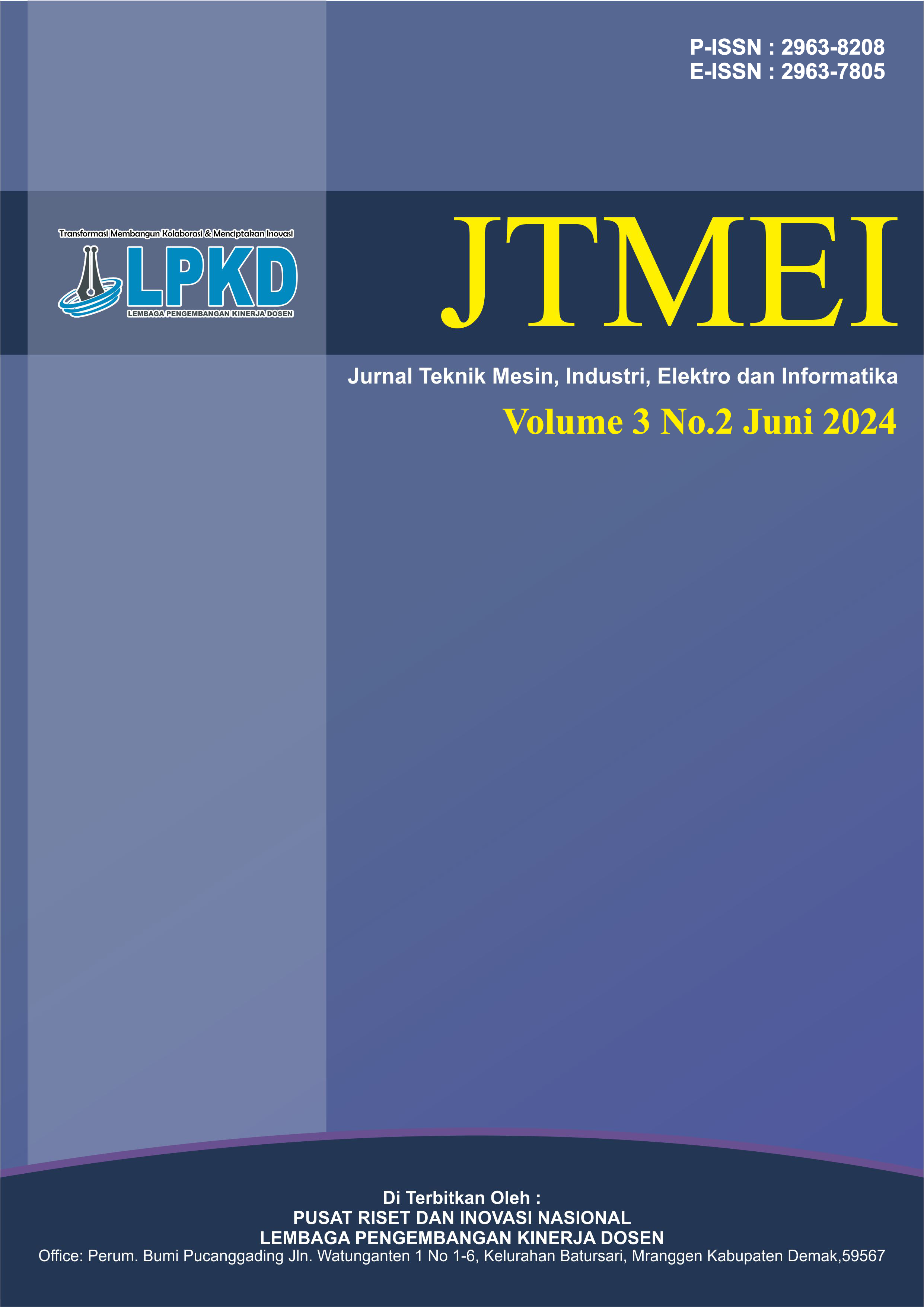Sistem Keselamatan Terhadap Kebisingan Di Kamar Mesin Berbasis Mikrokontroler Arduino Uno
DOI:
https://doi.org/10.55606/jtmei.v3i2.3755Keywords:
Arduino Uno, Sensor Suara KY-037, Push Button, Kamar MesinAbstract
One of the organs in the body that can help humans maintain balance is the ear. One of the body's main sound-producing organs is the ear, which also produces sound because it has unique receptors that can detect sound waves. However, the frequency range between 20 Hz and 20,000 Hz is the high limit that the ear can hear. This is why individuals often experience acute hearing loss after exposure to loud sounds or more than 20,000 Hz. A tool that can detect noise in an area, such as in an engine room, was created to overcome this problem, especially on ships After designing the tool and testing the safety system tool for noise in the engine room based on the Arduino Uno microcontroller, this system became a new technology for monitoring noise in the engine room. Then testing on all sensor readings worked well with an average percentage error on the ship running 0.70% and on the ship stopping 1.19% and the distance between the transmitter and receiver reaching a range of 290 cm without obstructions and with obstructions reaching around 130 cm. After all the equipment is working properly, earmuffs can be used to protect human hearing by educating all crew members to be able to use earmuffs when entering the engine room or going to work.
Downloads
References
Dewa, B. S., Santoso, I. H., & Fardan, F. (2023). Perancangan dan implementasi alat pendeteksi kebisingan kendaraan bermotor berbasis Internet of Things dengan menggunakan sensor KY-037 dan sensor MAX4466. eProceedings of Engineering, 9(6).
Erika, D. S. (2018). Optimalisasi penggunaan alat keselamatan kerja terhadap tenaga kerja bongkar muat guna menunjang proses bongkar muat di Pelabuhan Semen Indonesia Tuban (Doctoral dissertation, Politeknik Ilmu Pelayaran Semarang).
Fika, K. Y., Nisa, N. H. P. K., & Dewi, S. M. (2018). Rencana pelaksanaan pembelajaran materi energi bunyi. Universitas Muhammadiyah Sidoarjo.
Hendrawan, A. (2020, January). Analisa tingkat kebisingan kamar mesin pada kapal. In Wijayakusuma Prosiding Seminar Nasional (Vol. 1, No. 1, pp. 10-15).
Ikhvan, R. N. A. (2022). Perawatan injector untuk mendukung kinerja mesin induk di kapal KM. Tanto Abadi. Karya Tulis.
Ilham, A. F. S. (2021). Implementasi keselamatan dan kesehatan kerja (K3) dalam pembuatan kapal di PT. PAL Indonesia (Persero). Karya Tulis.
Isnan, A. J., Nugroho, T. F., & Baheramsyah, I. H. A. (n.d.). Analisa tingkat kebisingan di kamar mesin dan ruang akomodasi pada kapal penyeberangan Ketapang-Gilimanuk serta pemilihan alternatif peredaman.
Kustaman, R. (2017). Bunyi dan manusia. ProTVF, 1(2), 117-124.
Labolo, A. Y., Anas, A., Betrisandi, B., & Yunus, W. (2022). Penerapan metode Fuzzy Mamdani untuk mendeteksi penyakit telinga pada Puskesmas Marisa. Simtek: Jurnal Sistem Informasi dan Teknik Komputer, 7(1), 69-73.
Nasution, M. (2019). Ambang batas kebisingan lingkungan kerja agar tetap sehat dan semangat dalam bekerja. Buletin Utama Teknik, 15(1), 87-90.
Pangestu, M. I. (2022). Analisis tingginya kecelakaan kerja di kamar mesin MT. Asike 1 (Doctoral dissertation, Politeknik Ilmu Pelayaran Semarang).
Rosmanila, R., Radillah, T., & Sofiyan, A. (2018). Prototype lemari pengering pakaian otomatis. Informatika, 10(1), 32-38.
Simbar, V., Sandra, R., & Syahrin, A. (2017). Prototype sistem monitoring temperatur menggunakan Arduino Uno R3 dengan komunikasi wireless. Jurnal Teknik Mesin Mercu Buana, 5(4), 175-180.
Wibowo, R., Samuel, S., & Budiarto, U. (2014). Analisa tingkat kebisingan kamar mesin pada kapal KMP. Muria. Jurnal Teknik Perkapalan, 2(4).
Downloads
Published
How to Cite
Issue
Section
License
Copyright (c) 2024 Jurnal Teknik Mesin, Industri, Elektro dan Informatika

This work is licensed under a Creative Commons Attribution-ShareAlike 4.0 International License.








